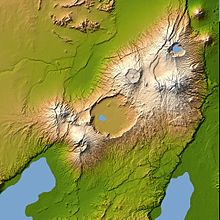Below is an alphabetical list of plants occurring in the Ngorongoro Crater in Tanzania.
Contents
Ngorongoro Crater covers an area of 265 square kilometres and is thought to have been formed from the collapse of a volcanic mountain which had become inactive. Its rim lies some 2280 meters above sea level, while the floor is at 1800 meters. The diversity of landforms and altitude has produced similarly diverse habitats of mountains, gallery forests, craters, grassy plains, black folk, lakes and woodlands, ranging from arid and semi-arid communities below 1,300 m with abundant grazing to montane vegetation with tall grassland, open moors and relict evergreen montane forests on the steep slopes. There is a large stand of bamboo, Yushania alpina , on Oldeani (an extinct volcano of 3,188 meters) and Pencil Cedar, Juniperus procera , on Makarut Mountain. There are four extinct volcanic peaks, all over 3,000 meters, the highest of which is Loolmalasin (3,648 m). Within the crater lies Lake Magadi, a small soda lake. (Hillary Remen)
The crater floor consists of shortgrass savanna punctuated by shallow, fresh and brackish lakes, marshes and swamps. Two notable forests are Lerai Forest and Laiyanai Forest, while the surrounds of Lake Eyasi are dominated by Acacia mellifera and Dalbergia melanoxylon during the dry season. [1]



